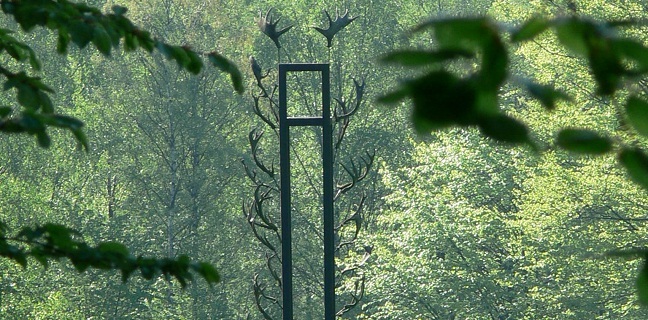
Marina Abramović
(Född/Born 1946, verksam i/works in New York)
The Hunt Chair for Animal Spirits, 1998
Betong, hjort- och älghorn, stål/Concrete, deer and moose antlers, steel
Höjd/Height 1200 cm
Tack till/Thanks to KnislingeVerken AB, Broby Sprutmålning
For English please scroll down
Marina Abramović intresserade sig för jakten som bedrivs på Wanås under sitt besök och det blev utgångspunkten för konstverket The Hunt Chair for Animal Spirits. Långt ut i parken står hennes 12 meter höga stol i landskapet. Längs stolsbenen har jägarnas troféer – hjort- och älghorn – fästs. Verket ingår i en serie som Abramović kallar Transitory Objects for Human and Non-Human Use, som hon arbetat med sedan början av 1990-talet. Syftet med konstverken är att synliggöra det som inte syns. Hon fick idén till objekten när hon vandrade längs kinesiska muren i en performance som saknade publik, och hon ville överföra energin och känslan av avsaknad till fysiska objekt. På Wanås är det en stol – ett objekt som ofta förekommer i hennes performanceverk.
Marina Abramović är en av världens mest kända performancekonstnärer. Smärta, tabun, uthållighet, tid, ritualer och intimitet är återkommande teman i hennes arbeten sedan 1970-talet. ”Kärnan i mina verk är kroppen”, säger hon om sitt arbete, som ofta testar hennes kropps fysiska och mentala kapacitet och tänjer på publikens gränser. I Rhythm 0 från 1974 placerade hon 72 objekt på ett bord, allt från en fjäder till en laddad pistol, och instruerade publiken att använda objekten hur de ville på henne. 2010 genomförde hon en monumental performance på Museum of Modern Art i New York. Under två och en halv månad satt hon under museets öppettider på en stol bakom ett bord i en av de stora utställningssalarna och bjöd publiken att komma och sätta sig, en och en, mitt emot henne och möta hennes blick under tystnad.
>>>
Marina Abramović became interested in the hunt that takes place at Wanås and that became the point of departure for the artwork The Hunt Chair for Animal Spirits. In a remote location in the park, her 12-meter-high chair rises out of the landscape. Hunters’ trophies—deer and moose antlers—have been attached along the legs of the chair. The artwork is part of a series that Abramović calls Transitory Objects for Human and Non-Human Use. The purpose of the artworks is to make the invisible visible. She had the idea for the objects when she wandered along the Great Wall of China in a performance with no audience, and she wanted to transfer that energy and feeling of loss to physical objects. At Wanås it is a chair, an object that often appears in her performance pieces.
Marina Abramović is one of the world’s most well-known performance artists. Pain, taboos, endurance, time, rituals, and intimacy have been recurring themes in her work since the 1970s. “The body is at the core of my works,” she says of her art, which often tests her body’s physical and mental capacity and stretches the limits of the audience. In Rhythm 0 from 1974, she placed 72 objects on a table, ranging from a feather to a loaded pistol, and instructed the audience to use the objects on her however they wanted. In 2010, she carried out a monumental performance at the Museum of Modern Art in New York. For two and a half months, she sat on a chair behind a table during the museum’s open hours and invited the public to sit down, one by one, directly across from her, meeting her gaze in silence.